Aston Parish Church: St Peter & St Paul, Birmingham - Monuments
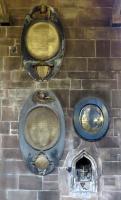
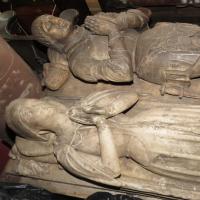
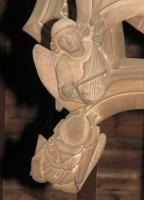
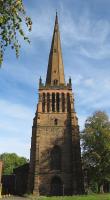
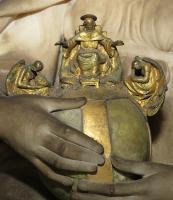


Aston Parish Church, St Peter & St Paul, contains an outstanding collection of grand tombs with statues
recumbent effigies and around 35 or 40 wall panels or mural monuments. As a whole, the group is worthy
of a great cathedral.
The Church itself:
The most noticeable characteristic of Aston Parish Church is the large spire, which has had various restorations and rebuildings
through to the late 18th Century, and stands upon the tower, which is 15th Century, at least the base and the outer walls,
and which is most of what is left from the mediaeval church. The late Victorian enlargement and essentially replacement
of that church took place in 1879-1889, with the porch as late as 1908, the architect being the talented J. H. Chatwin.
His work includes the richly decorated Erdington Chapel to the south side, the gift of an anonymous donor. With the rebuilding,
the Church appears from the outside to be unified, complete in itself, made in a fine reddish sandstone, with pinnacles,
buttresses, battlements, and a generally restless surface and outline giving great character. The style is 14th Century.
Inside, the body of the Church is long, tall and tall, with pillared arches separating nave from aisles, and a clerestory.
The monuments we have come to see are dotted along the aisle walls, with the grand effigies towards the Chancel end and in the Erdington Chapel.

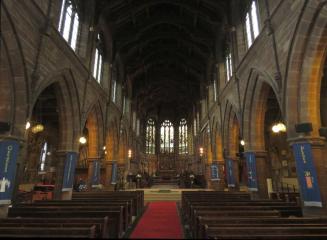
St Peter & St Paul, Aston Parish Church, exterior and interior.
We start with the recumbent effigies, of which there are no less than six tombs, and 10 effigies, a remarkable collection.
They are puzzling, but we are helped by an early book, The Antiquities of Warwickshire by William Dugdale, published in 1656
(online at the Internet Archive, https://ia802704.us.archive.org/22/items/antiquitiesofwar00dugd/antiquitiesofwar00dugd.pdf ),
with several pages on St Peter and St Paul, Aston, and a few illustrations of some of the grand tombs.
Recumbent Effigies: c.1360-1620s

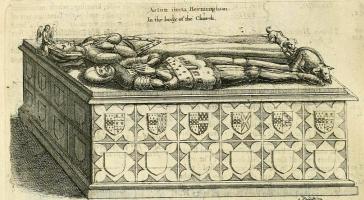
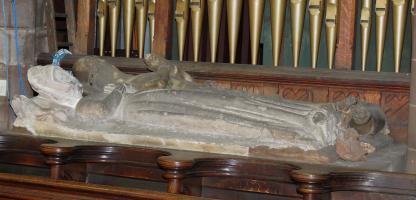
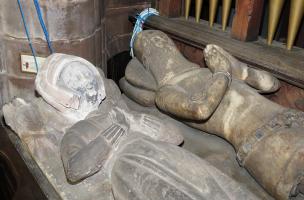
Recumbent effigies: likely Ralph Arden, c.1360, and Elizabeth Clodshale, c.1490 - and Dugdale illustration showing the effigies reversed.
- Arden monument, c.1360. The tomb now rests in front of the organ pipes, under one of the beautiful ogee
(onion shaped) arches with pendant half-angels designed by J.A. Chatwin. The modern plaque suggests the two figures as
Ralph Arden, c.1360, an ancestor of William Shakespeare s mother, and Elizabeth Clodshale, c.1490, wife of Robert Arden w
ho was killed in the Wars of the Roses. The Revd. W. Eliot, Vicar of the Church, who wrote a book on the Church published
in 1889, suggested the male figure as Sir T. Arden of Nechells. Certainly the two figures do not belong next to each other,
as he is carved in alabaster, and she in a dark grey stone. The female figure is closer to the viewer, and disconcerting
because of her head, paler and too high on her neck, after some breakage. The features are rudimentary and stylised,
either a greatly damaged original or some reproduction or restoration gone wrong. The carving of the body is much better,
simply carved but with a suggestion of comely youthfulness, with narrow, high waist and long, flowing drapes beneath.
The arms are short, the hands plump and short too, held in the expected attitude of prayer. Far better is the male figure,
a self-assured piece of carving with good proportion
and fine lines to leg and hip and arm. He wears plate armour, and that strange oversized helm with chainmail neck guard
called the Bascinet. But what we see of his face is finely featured, and his hands too are carefully rendered,
and there is detail to his armour, which has decorated joints and a belt with lapis lazuli. Dugdale illustrates this tomb,
and while his engraver is not particularly accurate, the picture shows a more proportionate head to the female,
and complete animals at their feet a boar for him, a dog for her where today they are battered enough to be difficult
to recognise. Oddly, the figures are swapped round, which might indeed have happened when the new Church was built,
though we must question the point of putting the more finely carved figure away from the viewer.
 William Harcourt, d.1482, perhaps.
William Harcourt, d.1482, perhaps.
- 15th Century effigy, perhaps Sir William Harcourt, d.1482 or afterwards. In the Erdington Chapel,
the portion of the Church wherein lie the monuments from the Erdington Chantrey in the old Church, is this partial effigy
of another knight in armour. He is missing his legs, and is quite battered, especially the face, but we see the details
of his armour and decorated belt, slender arms with praying hands. He was discovered in 1859 under the floor, and the
attribution to Sir William Harcourt is quoted by the Revd. Eliot, on the basis that he had in his will asked to be buried
in the Church he also suggested that the effigy may be the true companion of the female above, identified tentatively as
Elizabeth Clodshale - it is another stone figure, and the level of detailing is not dissimilar.
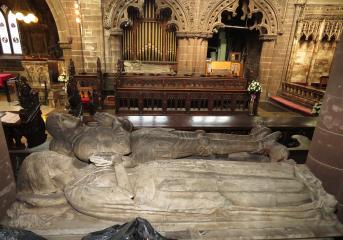

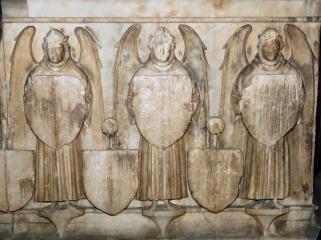
Sir Thomas de Erdington, d.1434, and Lady Joyce, and relief carvings of angels on the base.
- Sir Thomas de Erdington, d.1434, and Lady Joyce, 15th Century the first of our definite Erdington effigies,
and perhaps the most splendid, sculpturally, as befits the founder of the Chantrey chapel that bears the family name.
He is a broad-faced figure, with straight-cut hair, solid neck, and powerful body clad in plate mail; his head rests
on his helm. Just above his armoured hands, which are in prayer, we see a chain on his breast. His feet rest on
a heraldic lion, with the broad smile of a gargoyle and deer-like body. There is a contrast between the stylised,
flattened face of Sir Thomas and the sophistication of the carving of his armour. Next to his statue, that of Lady Joyce
is far more slender, delicate of face, neck and torso; the difference between his waist and hers, and his heavy arms
and her fragile ones, could not be more striking. She wears a nice headdress, of a shape familiar from medieval tapestries,
and wears a robe cut away at the sides over a tight top. The lines of drapery fall nearly to the ground, where they are
caught up on the bodies of two small dogs. Charming. Along the sides of the monument, the bed as it were, is a line
of half a dozen angels carved in high relief, more or less identical apart from the large shield each one holds in front
of them; further shields stand between them.
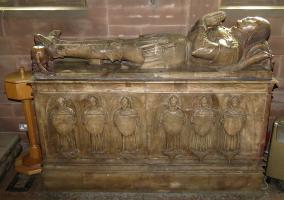
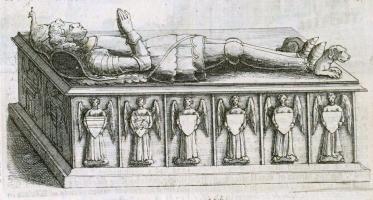
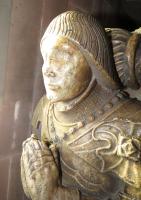
Thomas Erdington, father of the Chantry builder.
- Thomas Erdington, father of the Chantry builder. The attribution is on the basis of a note in Dugdale
of a now-lost tablet above the tomb saying that Sir Robert Holt, Baronet, had put up this monument as a memorial to
the Erdingtons. Another fine figure of an armoured knight, almost perfectly preserved, but no wife this time.
The face is more realistic, or less timewarn, than in the previous monument, and there is fine detail to his chain, the armour,
the dagger hilt by his side. His feet rest against a small dog. There are again angels around the base of the tomb,
with most of the detail of their faces preserved. The picture in Dugdale shows a certain lack of true detail,
but is interesting in that we see the other side of the monument from that which can be seen in its position in
the Victorian Church today.
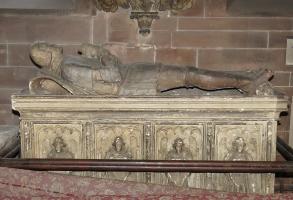

William Holte, d.1514, and wife Diana.
- William Holte, d. 1514, and his wife Joanna. The picture in Dugdale shows an inscription around the edge
of the monument which has disappeared, which give s the attribution; the wife is called Jane here. He is a significantly
taller as well as a broader figure than she is, but the figures are clearly matched. The faces still rather crude,
especially so when compared to the rest of the figure carving, but the outline of her head is good, and again an
elegant headdress. Four angelic figures with shields on the visible side of the monument. We will meet more Holtes in
the mural monuments noted lower down this page.
- Sir Edward Devereux,d.1622, and Lady Katherine, d.1627 a modern note says that she raised the tomb to her husband,
and her figure was added by her son after she died. What a change from the earlier monuments: the standard of carving is high,
but in place of the girlish females of earlier times, we have a broad-faced older woman with vast ruff, and shapeless mass
of drapery over her body. Look at the arms though, with the outer layer of the sleeve stretched open and held by buttons,
the rich ruffs at the cuffs, the modern looking shoes protruding from ranked petticoats at the base. And Sir Edward
high cheekbones, oriental-looking eyes, downward drooping mouth and carefully groomed beard, a cap above.
Then a great ruff exceeded only by that of his wife, great mantle over the civilian clothes and pantaloons of a merchant
rather than a warrior. These figures could kneel up in company with any Elizabethan or Jacobite kneeler monument
(see the Edward Holte monument below), greatly differing from the earlier statues which belong to a different world.
On the front of the monument we have their nine children,
five male and four female, all of each sex indistinguishable the one from another, in attitudes of prayer,
miniature copies of their parents. And we have the full canopy above and behind the effigies
thus a great arch and heavy shelves, pillars to the sides, all bearing painted shields of arms, and the back holding
the dark inscribed panel and strapwork decoration in low relief with cabochons and another shield of arms.
All in colourful alabaster.
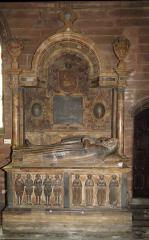

Sir Edward Devereux, d.1622, and Lady Katherine, d.1627.
The rest of the Monuments
Pre-18th Century:
18th Century Monuments:
- Henry Charles, d.1700, servant for 33 years to the Baronets Sir Robert Holte and Sir Charles Holte.
A fine example of a hanging drape monument. Thus the oval panel bearing the inscription is surrounded with a pale marble panel
carved as a drape, hanging from an upper inverted bowl, pulled to the side where it is tied in knots clasped by small rings,
then hanging down in almost symmetrical folds on either side, and then a curve of relatively unpleated expanse below,
all with a nice fringe, as in earlier monuments, and with a small single central support below. Delicate and well carved.
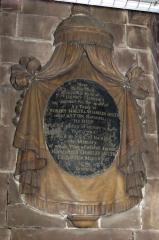

Early 18th Century monuments: Henry Charles and Sir John Bridgeman, Bt.
- Sir John Bridgeman, Baronet, d.1710, of Castle Bromwich, eldest Son and Heir of Sir Orlando Bridgeman of
Great Lever in the County of Lancaster, Baronet, Lord Keeper of the great Seal of England, by Judith Kynaston, Daughter and
Heiress of John Kynaston of Moreton in the County of Salop etc, and listing is five sons and seven daughters,
with a small note, almost a codicil, to his wife, Mary, Lady Bridgeman, d.1713, daughter and heiress of
George Craddock of Caverswall Castle, Staffordshire. On a cartouche below it is noted that Charlotte Bridgeman,
out of a filial regard to the Memory of her dear and worthy Parents, erected this Monument at her own Expence,
Anno Domini 1726 . It took her 11 years to do it, but worth the wait. The inscribed panel, raised to a semicircle at the top,
is within a similarly shaped surround, with a curved shelf above, a variation on a completely open pediment.
On top of this is a rounded pot in an oval surround, and on each side a mourning cherub reclines on a scroll.
One holds a downward pointing torch (signifying the snuffing out of life), while the other dabs at his eye with a handkerchief.
At the very top, the coat of arms within a small cartouche. More scrolls to the sides of the main panel,
and then beneath the base, two curly, fluted supporting brackets and the large cartouche with the note about the daughter.
A very small lozenge of arms at the bottom. Most splendid, and signed right in the centre of the lower shelf by the architect,
Jacobo Gibbs [James Gibbs], who designed St Martin in the Fields. Gunnis, the monumental historian, tells us the sculptor was
John Michael Rysbrack, no less. More on this and another monument by Rysbrack in the Church
on this page.
- Charles King, d.1712 (the dedication is at the very top of the monument), great grandson of John, Bishop of London, with a long Latin inscription
on the main panel below,
concluding that the monument was erected by Richard Culliford, his brother in law (with thanks to Geoff Allibone for correcting
my mis-attribution).
Another grand Baroque piece. To the sides are receding pairs of pilasters, supporting a heavy shelf, also with receding sides.
On top of this is the coat of arms, surrounded by mantling and foliage, and to the sides are two urns, with gadrooned tops
and bases, most elegant in the same heavy way as the rest of the monument. At the base is another shelf, also gadrooned,
and beneath this are the supports, each with a winged cherub head at the bottom, and in the middle a relief carving of a globe
on a stand and various scientific instruments, indicative of the interests of the deceased. In the centre under that is a corbel
carved with Acanthus leaves. Extremely good carving.
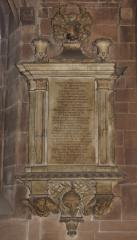
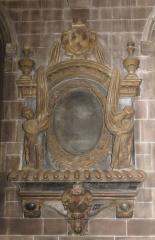
Early 18th Century monuments: Charles King and William Booth.
- William Booth, d.1673, his son William, d.1679, and his wife Esther Booth, d.1696, who erected the monument.
A splendid thing, based upon an oval composition. Thus the lengthy inscription is on a black oval, and surrounding it is a line
of repeating flowers, with the base also including crossed branches. To the sides stand naked putti,
each holding a curtain swept back from the inscribed panel, and one of which is also using the curtain to dry his tears.
At the top, a gently domed arch, with repeating leaf designs carved in low relief; the tops of the curtains disappear
behind this, then rise to the edges of a cartouche of arms in the central position. To the sides, above the cherubs,
are flaming urns, vase shaped and of uncommon elegance. The base of the monument has the gadrooned shelf common for this period,
and beneath this, a central cartouche of arms, cabuchons on the supports at the sides, and at the lowest point,
a small winged cherub head. All in fine brownish alabaster and black marble. Very good and of its time.
- Charles Holte [Carolus Holte], Baronet, d.1722, with a lengthy Latin inscription noting his descent,
and contributions to medicine and justice etc etc, erected by his wife Anna [Clobery]. Similar to the earlier
Thomas Holte monument, but not quite so ornate. As with the earlier memorial, the inscribed panel has above it a carving
of winged cherub heads, and lots of flowers, and above that is a semicircular arch, whose sides rest on pillars,
Corinthian here. To the sides of the pillars stand a pair of cherubs, one gesturing melodramatically towards the central panel,
the other clasping his hands in an attitude of grief. On top of the pillars are framing urns, with the centre of the arch,
as usual, bearing the coat of arms, on an ornately carved cartouche with more flowers. The base of the monument has
curly brackets, and a central panel noting his wife Anna Clobery and their eldest son, Clobery Holte, Baronet.
- Diana Holte, d.1724, daughter of Sir Charles Holte, Baronet, and Dame Ann, his wife:
it was the latter who erected the monument. The inscription is on the flat surface of a stretched out piece of drapery,
hanging from the top and upper corners, and falling in nice folds to the sides; outside of this are spiral sidepieces
with flowers heaped on them. There is a shelf above and below; above the upper shelf, without any entablature,
though the shelf is quite deep, is a broken curly (swan-necked) pediment, with a central pot, gadrooned top and bottom.
At the base is an apron, bearing a lozenge of arms with two crossed branches carved in relief. A good thing.

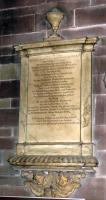
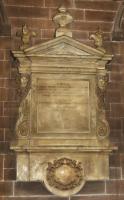
1720s-30s panels: Diana Holte, the Revd. Josiah Foster, and Robert Holden.
- The Revd. Josiah Foster, d.1727, Vicar of the Church, with a eulogy describing him as
a rather too upstanding individual, His Admonitions were Grave and Powerfull: // The Repentant Found Comfort from Them,
// And the Obstinate Sinner Confusion of Face. Also noting he married Susanna Iannes, daughter of the Vicar of Sedgley,
who erected the monument. Like the deceased, a rather austere panel, with receding sides and Classically correct upper shelf
and small urn on top, while the lower portion is more extravagant: a generous gadrooned (corrugated) lower shelf,
and a pair of winged cherub heads below with a bit of foliage. By Thomas White of Worcester.
- Robert Holden, d.1730, his wife Letitia [Levinge] Holden d.1751, and a daughter, Catherine, d.[?]1752,
with other members of the family added in a different script. Another grand panel, of quite complex geometry,
more a piece of architecture in its own right. The central inscribed panel is within a plain frame,
on top of which is a tall entablature with an empty pediment above; there are receding sides, with demi-angels,
or angel heads with necks and long wings but no more, to the sides, acting as caryatids, bearing the shelf ends above,
and with coiled decoration below. At the top, a central funereal urn, and flaming ewers to the sides, nicely Baroque
in their proportions. At the base is a shelf with a deep apron underneath, bearing a finely carved central cartouche,
which once would have held a painted coat of arms. The monument is signed by [J] Mi. Rysbrack, and dated 1753
it is our friend John Michael Rysbrack [Rysbrach] whom we met as the carver of the Baronet Bridgeman monument noted above.
There used to be other Holden monuments in the Church, but these were lost.
- John Hausted, d.1755, with a Latin inscription. The tall panel has receding sides,
and on top is an entablature and shelf, on which rests a small funeral urn carved in alto relievo,
with a heap of festooned flowers on either side; there has been some damage and there is clearly something missing
it may be that there was a flame on top, and the festoons were set at a less upward angle originally.
At the base, a rounded shelf, supported on curved, fluted brackets, with between them, a winged cherub head, plump of cheek
and low of forehead. The carving, both of this and of the floral things above, is very assured and with an appreciation of
the scale appropriate to the scale and material.
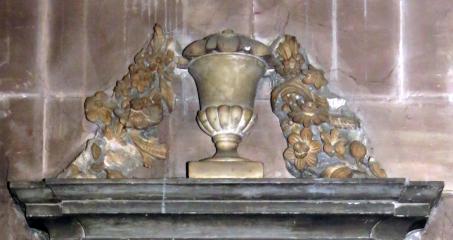
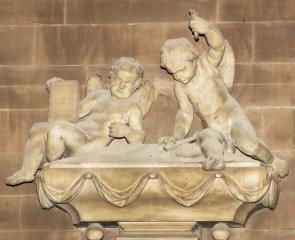
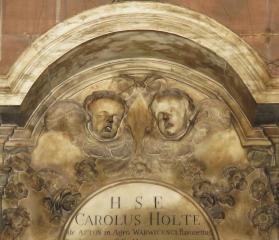
Later 18th Century carved tops of monuments: John Hausted, Thomas Caldecott, Charles Holte.
- Thomas Caldecott, d.1774, and added later, his wife Catherine [Holden], d.1788,
whose father was the Robert Holden whose monument we noted above, another flamboyant Baroque monument.
The inscribed panel is dark, crisply cut with the lettering so it has the look of slate,
set within a broad frame of light stone with receding curly sidepieces and a curved base bearing a miniature cartouche of arms
(the paint has mostly gone), with a nicely carved cord to either side caught on a pair of nails;
on close examination the cord is made of tiny leaves. Above is a shelf, and then a generously sized casket tomb
in alto relievo, resting on balls rather than feet, and a central stand, on the front of which is a low relief carving
of crossed branches of olive and grape, curled round to fill the space. The casket has small drapes festooned all the way round,
and on top sit two chunky cherubs. One sits up, resting on one hand while the other holds aloft a torch,
his other hand rests on a discarded pair of scales, representing the injustice of the death of Mr Caldecott.
The other cherub reclines in studied relaxedness, a bible resting on one plump thigh. The composition is careful:
nothing could be more asymmetric than the two cherubs, but their collective outline forms a triangle with the apex
on the raised arm of the one, a little to right of centre, so that variety and balance are both achieved.
- Egerton Bagot, d.1775, an oval white panel in a taller but not much wider black surround
had the monument been tilted on its side it would have the aspect of an eye. Above, a winged cherub head,
one wing folded inward and forward in an affectation of the time; below, a shield of arms with minor foliage. Walter Bagot,
his fried, relative and heir, erected the tablet.
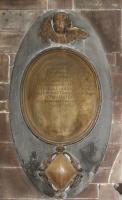
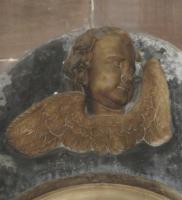 Oval panel to Honora Bagot, and cherub head from Egerton Bagon panel.
Oval panel to Honora Bagot, and cherub head from Egerton Bagon panel.
- Honora Bagot, erected 1776, wife of Thomas Arden Bagot, and with the link made to the Bridgewater family,
for she was daughter of Sir William Egerton, son of John, Earl of Bridgewater. Similar to the Egerton Bagot panel
in the dimensions of inner and outer oval, with similar winged cherub head facing the other way, but a lozenge of arms
rather than a shield below, again with minor foliage.
- Robert Dallaway, d.1779? and his wife Priscilla, d.1788? and offspring.
A casket end, with outward-slanting sides, fluted, and a shallow lid on top above a lip; the base is supported on feet
carved as upturned bunches of leaves, roughly bell shaped, seated on a separate lower shelf, which is conventional.
- William Dallaway, d.1781, and his wife Sarah, d.1773. An oval panel on an oval backing.
The inscription is nicely curved in some fancy of the sculptor, and on top is a winged cherub head, with blue-bell like flowers
depending down either side to mid way, which is conventional, as are the crossed frondy branches underneath.
- Sir Charles Holte, Baronet, d.1782, with an account of his descent and that his daughter was
deprived of the patrimony of her ancestors by the will of her uncle, Sir Lister Holte, Baronet, and with a short eulogy
to Sir Charles by his wife. A fine obelisk monument. The black marble obelisk, very wide at the top, is over two thirds
the total height of the monument, and serves as the backing for a sculptural group of the widow grieving over the alto relievo
portrait of her husband, and clasping the base of a large, ornate pot draped with a wreath of flowers and fruit;
a bough in her hand has been partly lost. It is the habit of the time, looking rather casual today, for the female figure
to lean her elbow on some part of the monument, and here her elbow rests on top of the portrait roundel,
cushioned by her bounteous sleeve which lies on his hair. There are elements of the figure which look a little uneasy
her head appears a touch large for her narrow shoulders, her arm, apparently resting on the top of the roundel,
could have been an inch lower, her off-the shoulder drapery is low on one side but reveals little sign of a breast,
but nevertheless this is a fine piece of sculpture. The composition is nicely arranged, as is the unnamed widow s figure,
her face shows a degree of pathos, and her arm, hands and feet are well modelled. Sir Charles s face, in profile,
suggests an ascetic, intelligent scholar, with high forehead and ringletted hair, a quizzical brow,
slightly hooked nose and characterful mouth. The sculptor, who alas seems to have left no signature which I could see,
clearly delighted in the detail of the wreath on the pot. A good thing and a real ornament to the Church, able to hold its own
with the best of the monuments.
- Tho[mas] Brooke, d.1780, John Brooke, d.1802, and Sophia Jane Allicia Kelly, d.1810, an infant.
A grand obelisk monument, the obelisk being only a subsidiary part of the whole. The monument centres on the inscribed panel,
a delicate oval with a thin border. Above this, slight drapes hang from a central point, are caught at the sides,
and hang down to almost half way; the lower portion of the oval has crossed ferny branches cradling it.
To the sides, tall, slender pillars, one with a surviving urn upon it. All this is on a grey panel, rising at the centre
to a small white shelf on which once rested a larger urn, but only the scratched background to this now remains;
we see that it had small drapes hanging from the sides, presumably the handles, which joined to some further thin drapery,
or perhaps garlands of flowers, which would have connected to the urns on the sides. Above, near the apex of the black obelisk
which forms the back to these things, is a winged cherub head looking somewhat to the viewer s left.
Beneath, a shelf with protruding sides to hold the pillars, is held up on curved brackets, more substantial than
the delicate carving above, and between these is a short, curved apron bearing a shield of arms and the traces of
more little garlands. There is a dark shaped backing to this. The effect overall, even with the damage and losses of parts
of the marble, is of delicacy and lightness, considerably different from the heavy solidity of most tomb designs.
The sculptor was William Thompson of Birmingham, who has other work in Birmingham Cathedral.
- Sir Lister Holte, Baronet, d.1770, and his third wife, Sarah [Newton] d. 1794, in which year the monument
was erected by her sister Elizabeth Newton. A casket, projecting greatly from the wall, with angled sides, a low pyramidal lid,
and, the only carving, lion s feet below, resting on a solid lower shelf, itself supported on a pair of blocks of marble.
By Richard Westmacott Senior.
- Brandwood family of Little Bromwich, with many members recorded from Edward Brandwood, d.1731
through to Jane Brandwood, d.1797, and members of the linked family of Charles Birch. The names are recorded on an oval panel
on the front of a tall obelisk. Such obelisk monuments were popular in the 18th Century, though the more usual type
has the inscribed panel below the obelisk, and a pot or other sculpture upon it. Anyway, this fine example has pots at the lower corners of the obelisk, and a winged cherub head, one wing raised, at the top, and a raised border in light stone, and a summit small flaming urn. At the base of the obelisk is the obligatory shelf, here quite deep, and decorated with fluting, a central mini cartouche and ovals to the sides on projections. Below these are ornate scrolly brackets with leaves carved in low relief, and a deep central apron rather than a panel, with crossed branches attached upon it, and terminated at the base by a bell shaped ornament, as indeed are the brackets. Not so conventional for an obelisk monument ones this late quite often varied considerably
from earlier, more constrained styles but assured and successful in the composition. It is signed at the base
by a local sculptor, Eglington Senior, of Birmingham.
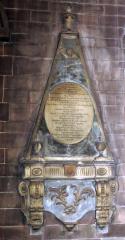
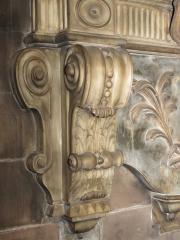

Eglington Senior of Birmingham: panel to the Brandwood family, and details.
19th and 20th Century Monuments:
- Rebecca Astbury, d.1803, and added later I think, husband William Astbury, d.1812, and a son,
James Astbury, d.1812. The panel forms the centre part of a casket monument, with outward sloping sides, dark with pale edging,
an upper, fluted shelf, and a low relief carving of a pot on top, on a broadening base. A wreath is around the top and
egg-shaped body of the pot. The casket rests on double ball feet, quite common, but instead of a simple shelf below,
which would be the norm, there is a further added panel, with receding sides and its own base and fluted brackets in support.
This commemorates William Astbury, d.1813, and Thomas Astbury, d.1820, the last surviving sons. At the very base is a lozenge,
referring to a will dated 1820, notes that Thomas Astbury gave funds towards a national School for Little Bromwich.
This sort of compound monument, with extra pieces added to an original to accommodate later members of the family,
are fairly widespread, but this case is unusual by linking to it the extra details of the bequest.
- Lieutenant Colonel William Conolly, d.1817, plain panel with narrow frame,
with an outer dark backing panel with its own outer frame.
- Ann Lander, d.1820. Late, short obelisk monument. The inscribed panel has an upper shelf
and rests on two small fluted feet; above the shelf is the obelisk, less high than the lower part of the monument,
and quite triangular. On the face of this is a relief carving of a semidraped pot, Classical and thin-stemmed.
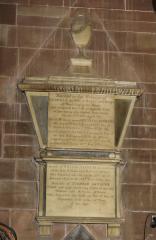
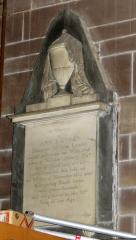

Early 19th Century vertical format panels: Astbury, Lander and Goddington.
- James Goddington, d.1821, and his wife Ann [Ashton] Goddington, d.1793. Tall panel, with upper curved pediment
with a bit of ornament between acroteria ( ears ) and the curved edge, which is unconventional, and a repeating
Roman S-shaped pattern below. Under the inscription is an alto relievo carving of a broad pot with a dying bough around
and above it. This rests on a shell, with wave patterns to either side across the top of the bulky base,
which also bears a blank panel and a pair of stylised flowers. Resting on two small block supports, on a black backing panel.
Signed by William Hollins, an important Birmingham sculptor.
- I missed seeing the panel to Benjamin Spencer, d.1823, vicar of the Parish for 52 years,
which is also by William Hollins.
- Revd. George Peake, d.1830, Vicar of the Church, and his wife Matilda Hanwell, d.1864.
Styled as a simple tomb chest end with upper shelf and little feet, on a shaped black backing panel bearing a painted shield
of arms at the top; there may have been some ornaments at the sides of the shelf, as there is a discoloured shape on one side.
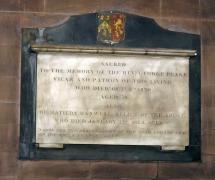
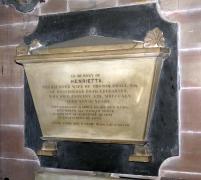
Horizontal panels: Revd. Peake, d.1830, and Henrietta Small, d.1845.
- Henrietta Small, d.1845. Another casket tomb, this one with a well proportioned upper shelf or rim
and a low lid, with acroteria at the sides and the remains of one at the apex. The casket has lion feet,
which rest on separate tiny blocks rather than a shelf all the way across. On a black, shaped backing with nipped corners,
and signed by the stonemason, W. Lodge (picture above right).
- Revd. Egerton Arden Bagot, d.1861, of Pype Hayes, eldest son of the Revd. Walter Bagot,
Rector of Blithfield and Leigh in the County of Stafford. Plain white panel with surround.
- Edward Chattock de Bromwic [sic], d.1568 and others through to Thomas Chattock, d.1818
tablet erected in consequence of the removal of the memorial stones on the outside of the old chancel 1879.
Plain streaky white on black panel with block feet.

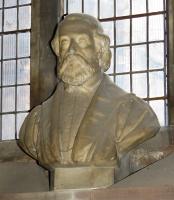
E.G. Papworth's bust of John Rogers.
- John Rogers, d.1555, panel erected in 1883, and associated with a fine marble bust of the deceased,
looking very much the Victorian gentleman rather than of such an early period. He is shown with wavy hair, high forehead,
trimmed beard and thick moustaches, and his clothing, though with the wide, deep collar seen in so many kneeler monuments,
still has the look of a Victorian coat. A very decent bust nevertheless, by the sculptor, E. G. Papworth, who exhibited in Birmingham in the early
1840s and later lived in London. The panel notes that it was moved from
St John s Church Deritend in 1940. The dates don't work - the panel is dated 1883, and Papworth died in 1866.
- Stephen Wallis, d.1844, his wife Mary Wallis, d.1832, and offspring to 1885,
plain tablet with streaky grey border, erected by desire of Mary Ann Hudson, probably on removal of the memorials
from outside the Church as in the case above.
- James Yates, d.1868, a plain rectangular panel.
- John Briscoe, d.1885, his wife Eliza Cicely Briscoe, d.1891, and William Henry Briscoe, d.1884.
Tomb chest end with moulded shelf, on black, shaped backing. Rather obscured behind a cupboard.
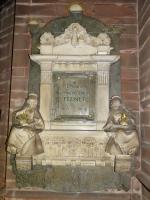
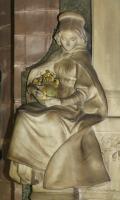
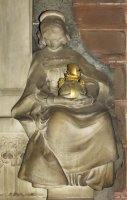
J.F. Feeney, d.1899, Arts and Crafts sculpture by George Frampton.
- John Frederick Feeney, d.1899, and on a separate panel beneath, a note that one of his sons paid for
the Chancel and Chapel of the Church to be built in 1885 in his father s memory the anonymous donor noted at the
top of this page. A true turn-of-the-19th Century monument, by the excellent sculptor George Frampton,
with a typical pair of small Arts and Crafts allegorical girls flanking the central panel. One cradles a globe,
with upon it a tiny figure seated on a throne, with two kneeling angels; the other holds a globe with a single-sailed ship
upon it, with a tall forecastle. Between them is a line of Arts and Crafts trees bearing hearts with the names of what
we must presume are Feeney s numerous children. At the top of the monument is a relief carving of a forest of clover leaves
or hearts with a central figure of Christ, a sun above. Frampton signs under one of the side figures,
and dates the monument 1901. A completely excellent thing.
- William Hodgson, d.1919, Hon. Canon of Birmingham, and Vicar of the Church 1917-1919, when he died
as the result of an accident on Christmas day. Pale panel in frame with mouldings, the latter made of
a beautiful red-brown and cream alabaster much favoured by the Arts and Crafts generation.
- Revd. Henry McGowan, d.1946, Vicar of the Church and later Bishop of Wakefield. Plain brass panel,
low and wide, with inscribed line border.
Brasses:
We may note at least the following:
- Thomas Holte, d.1545, Justice of North Wales and lord of this town of Aston , and his wife Margaret.
The figures are kneeling with the usual praying pose, and whlle his face is gone, they are otherwise complete.
She wears a headpiece, her face is young, her robes ambitiously delineated and rich.
- Humphrey Holden, d.1641, a small panel with inscription, with an associated shield of arms in a matrix.
- John Legard, d.1752, a small child. A brass oval, domed, with a wooden surround.
Perhaps once part of something bigger, but who knows what.
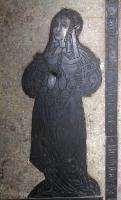

Brasses to Margaret Holte and John Legard, d.1752.
Modern brasses:
- George Peake, d.1876-1878, whatever that means, Vicar of the Church for 24 years.
Panel with inscribed line border, blackletter text, and red capitals and dates.
- Ellen Penelope Knox, d.1892, wife of the Vicar of the Church, Revd. E. A. Knox. Darkened brass panel
of a popular type, with the main initial letters in red, and an inscribed border, here generously wide with
a repeating floral design all the way around and with fleurs de lys in circles at the corners.
- Barbara Eliot, d.1894, wife of the Revd. William Eliot, Vicar of the Church and
Hon. Canon of Worcester Cathedral. Similar to the above in style, but with quatrefoils at the corners and
a different floral design. The Revd William Eliot wrote a nice book on the Church which lists out the inscriptions
on the monuments, including translations of the Latin ones, a rare luxury.
Also in the Church
- The base of a 13th Century preaching cross which once stood in the Churchyard, now in the Erdington Chapel.
Upon the sides we see a crucifixion, a Virgin and Child, and Saints Peter and Paul, the former with recognisable key.
- The stall figures, carved in wood. Really rather good they include the Evangelists, prophets, the Apostles,
and a few others including Jepphthah s daughter. Decorative and tactile.
- The Font, given by the pupils of Witton Hall School, alabaster, with massive short pillars at the base,
which is raised on three steps, and a bowl with Gothic blind windows all the way round, and a tall wooden spire as a cover.
- The Pulpit, 1885, given in memory of Henry Yates by his sons, presumably a relative of the James Yates
whose plain panel we saw. Quite a lot of carving: standing figures of Moses, Elijah and St Paul, and scenes showing Moses
and the Brazen Serpent, the Smiting of the Rock (also Moses), Christ in the temple, and the Miraculous draught of Fishes,
St Paul preaching at Athens, and Timothy learning the Scriptures.
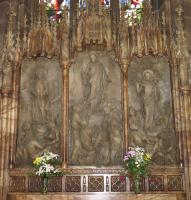
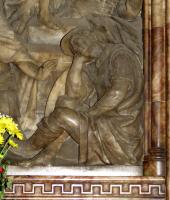
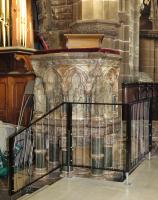
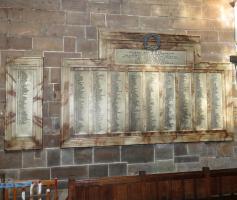
Carved alabaster: altar and detail, pulpit, Workd War I Memorial.
- The usual brass eagle lectern, quite ornate with little monsters at the feet.
- The altar, presumably of the same date, again all coloured alabaster, with scenes from the Life of Christ,
and standing figures of saints. Rich in effect.
- Various carvings in the interior, above all the lines of half-angels at the Chancel end, with below them,
shields of the great families connected with the Parish.
- Some bright stained glass by various hands, some really quite lively.
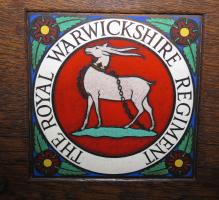
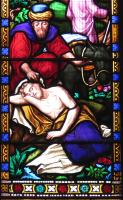
Royal Warwick arms in champleve enamel, sample stained glass.
- Nice mosaic floors, with stylised flowers
- The World War 1 Memorial to parishioners who fell in the Great War. A broad panel of alabaster
divided into many columns for the lists of names, and with a raised centre bearing awreath.
- The Royal Warwick Regiment War Memorial, in the form of a wooden lectern holding two books for WW1 and WW2
though of course it was erected after the First World War, and featuring three enamel panels at the top:
one with a goat in a roundel, the others with olive leaves, a very Arts and Crafts look.
Outside the Church
There is a variety of gargoyles on the exterior of the Chancel and on the front pinnacle, representing the Seven Deadly Sins
and various monsters. The majority of the Churchyard has been cleared, with lines of cropped tombstones lining the paths,
some of residual interest including several slate ones, lasting very well apart from having been hacked in half to give
a suitable height to put next to the paths, minor sculpture, and a few interesting designs such as keyhole stones.
A couple of great tomb chests survive, of which the larger one, raised up on steps, is to members of the Boyce family,
and this has upon it carved wreaths with downward pointing torches (life snuffed out). At the Chancel end of the Church
a small crop of standing tombstones survives, and her e we can spot a few members of the Astley family,
a Gothic blind window with crocketed pinnacles, and round the far side, two nice Classical tombs,
designed as tall blocks with pillars at the corners supporting Roman arches, to members of the Ansell and Keay families:
the latter has a surviving pot on top; further on are several pillar monuments with pots on top,
in granite.
Finally, we see by the wall of the Churchyard, a stone monument to the Royal Warwickshire Brigade, WW1;
the only sculptural decoration is the regimental insignia of a goat and a cross in low relief.
With many thanks to Sam Evans for kind permission to use pictures from inside the Church and a most interesting discussion on the Church;
the Church website at http://www.astonnechellscofe.org.uk/history_aston.
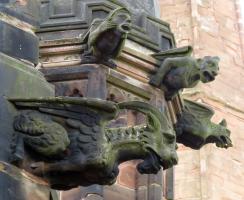

Top of page
Rysbrack panels in Aston Church
Birmingham churches: St Philip's Cathedral and Colmore Row // St Paul in the Square // St Chad's Cathedral // St Leonard's Bilston
Birmingham pages
Introduction to church monuments
Sculpture in some towns in England
Home
Visits to this page from 5 Nov 2017: 8,223



















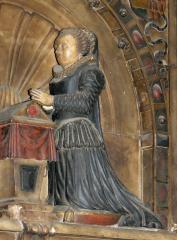
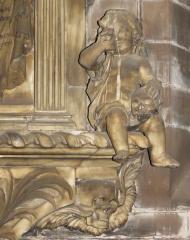











 Oval panel to Honora Bagot, and cherub head from Egerton Bagon panel.
Oval panel to Honora Bagot, and cherub head from Egerton Bagon panel.


















